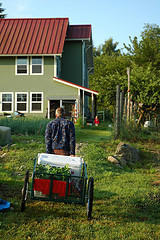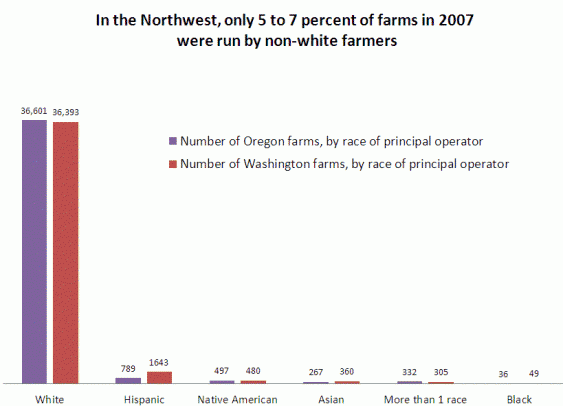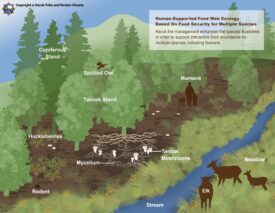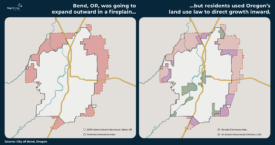In the Northwest, the average age of our farmers is 57 and climbing. And the chances are pretty overwhelming that a person running a farm will be white.
It’s certainly not that white people are the only ones who know how to farm. The region’s agricultural economy runs on Latino/Hispanic farmworkers who can weed a row in a matter of minutes, fix an irrigation system with whatever is handy, or nurse ailing tomato plants back to health. A diverse set of refugees from farming communities in eastern Africa or the highlands of Asia may never have seen a beet, but give them some seeds and a few months, and they’ll have sizeable ones.
There are a number of reasons why the region’s farms tend to be run by white people. For starters, those are the families who tend to own farmland, and it’s much easier to own a farm if you inherit one. Working in fields or orchards may teach you a lot about how to grow crops but not the business and marketing skills to turn a profit. Start-up farms require capital for everything from seeds to greenhouses to packing infrastructure, and people of color have not had equal access to credit that can grow a business. USDA programs designed to help farmers have not historically been geared towards reaching minorities. (And in some cases, federal farming programs have demonstrably discriminated against them.) All of that adds up to this crazy lopsided chart:
This doesn’t sit well with people like Don McMoran, who grew up on a commercial potato farm in Washington’s Skagit Valley, which produces everything from berries to pickling cucumbers to vegetable seed. Today, McMoran doesn’t spend as much time worrying about whether the crops will come in. Instead, he’s trying to keep some of the best agricultural land in the world from being turned into subdivisions. At his high school, there were about 20 kids from farming families like his. Today, only one is still farming.
McMoran, as a county extension agent for Washington State University, fields plenty of calls from insurance agents or baristas or public policy graduates who like the sound of growing kale for a living. But most have zero farming experience and little idea of how much work is involved. When he and his colleagues looked for the deepest pool of knowledgeable people who might begin to replace an alarming number of retiring farmers, Latino farmworkers made sense. So Skagit County became the first in the state to offer WSU’s beginning farming and business classes simultaneously in Spanish and English. McMoran also helped found the Viva Farms incubator, now in its third year, that helps course graduates and aspiring farmers (of any race) learn to run their own business and turn a profit. As he puts it:
I don’t want to see agriculture die because people aren’t getting involved. When you drive around Skagit County, it just kills me to see housing development going in on the best agricultural soil in the world. So we started thinking outside the box in terms of who we go after to find the next generation of farmers.
Any aspiring farmer needs a few critical things: affordable land, money to capitalize the business and make it through the early growing season with little or no income, infrastructure like irrigation pipe and greenhouses and coolers to keep produce from wilting or meat from spoiling, and customers to buy their products.
Farmers from socially or economically disadvantaged groups are no different, but they may face additional hurdles, including language barriers that prevent them from cold calling restaurants, a lack of experience with banks or credit, or even trouble meeting basic needs such as secure housing. Helping some of those populations get a foothold in farming requires targeted tools and programs that often haven’t been available to those communities. Eddie Hill, who works with refugee farmers at Seattle Tilth’s Farm Works incubator in South King County, puts it this way:
A farmer to me is someone who not only farms but someone who is economically breaking even or getting a small return on the work they’re doing. The farmers who are surviving are the ones who have someone in the house with a day job or some money or who have some kind of investor or investment or slow money. Those are the tools that help you get over the hump in farming, but they don’t exist for people just arriving in this country or people in historic poverty or people with bad credit.
Still, minority-operated farms were the fastest growing sector of farms in Washington from 2002 to 2007, the last year with complete data from the national Census of Agriculture (which will be updated next year with 2012 information.)
Where people farm and what they choose to grow also tends to vary by race. For example, Latino/Hispanic farm operators in Washington and Oregon are most often involved in cattle, hay and fruit production, mostly in the Eastern parts of the states. Asian farm operators lean towards fruit and melons, flowers, and nursery products, with a substantial concentration around Seattle and Bellingham. The number of farms operated by African-Americans and Pacific Islanders are so small that it’s hard to draw any conclusions. And farms operated by Native Americans tend to focus on cattle, hay, and aquaculture, according to the Census.
Much of the growth in Washington State comes from Hispanic/Latino farmers, despite numerous barriers, from a lack of culturally appropriate material to help them understand USDA programs and opportunities to difficulties in obtaining loans.
A recent survey conducted by the Center for Latino Farmers of Latino/Hispanic farmers and ranchers in Washington State sheds some light on how some had made that transition: 77 percent had been farmworkers before starting their own farm, 39 percent had not received any government assistance in their farming operations, and more than half still worked for someone else. They’ve relied on personal relationships, and have little knowledge of the USDA or its inner workings. And while they have tremendous abilities in producing food, many have serious gaps in understanding and managing the business side.
The report concludes:
The belief that all the new farmers and ranchers will come from FFA, 4-H and the Land Grant Institutions, needs to be re-thought. A closer look at what is occurring on the ground tells an expanding story of who is also producing the food for the American table…
One can just image how much more advanced the Hispanic/Latino farmers and ranchers would be if they were provided USDA programs and Extension education, i.e. from how to finance their farm to utilizing sustainable farming practices and marketing. One has to believe that one would see many more Hispanic/Latino farmers and ranchers owning and operating their own farms if these resources were made available to them.
In Oregon and Idaho, recent trends are more complicated. The number of farms operated by non-whites declined from 2002 to 2007 but the value of crops grown on those farms rose, suggesting that the market may be weeding out unsuccessful farms and rewarding ones that survive. For example, the number of Latino-operated farms in Idaho declined by 34 percent from 2002 to 2007, but the value of the crops grown on the thriving farms grew by 144 percent.
In terms of sheer efficiency, Asian and Hispanic farmers are able to wring more money from smaller plots of land. That can be the difference between growing high dollar niche crops on smaller suburban or urban plots and cattle ranching that takes a lot of dry rangeland to support one cow. But the differences are startling: In Oregon, for instance, Asian farmers on average made more than seven times more money from a single acre of land than white farmers.
As this year’s growing season draws to a close, we’ll spend the next few weeks looking at regional efforts to diversify the pool of Northwest farmers and invest in the next generation of food producers. From a Somali refugee trying to gain an economic toehold in this country to Latino farmworkers who have gone into business for themselves to the well established community of Hmong farmers, it can be an uphill battle.












Val Alexander
There is some good information from Tilth Producers about funding opportunities for beginning farmers. Washington Tilth just had their annual conference, which included classes for new farmers.
Roxanne Christensen
Rather than aiming to get small plot farmers to join the system, maybe it should be recognized that they have figured out a way to beat it. Their success has been codified in an online learning series called SPIN-Farming. It’s approach to farming maintains, and in many cases exceeds, the net income levels of conventional farming, while circumventing agriculture’s legacy issues that add complexity, costs and uncertainty for new farmers – land values, commodity markets, trade agreements, immigration policy, crop insurance, oil prices, credit availability.
To help more entrepreneurs successfully channel their energies into farming, the risks and costs to start a farm have to be reduced, and the farm learning process needs to be modernized and accelerated. By opening the door thought to be closed to all except those possessed of land, an agrarian heritage or rarified abilities., an approach like SPIN-Farming is helping to accomplish both.